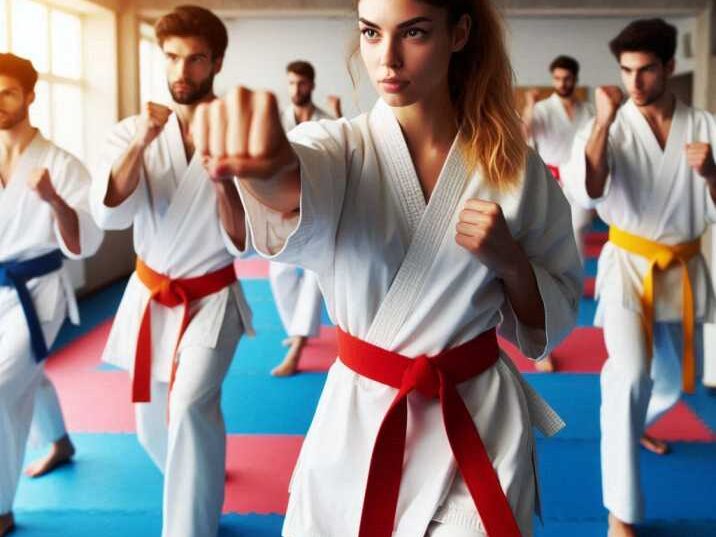Karate is a popular martial art that teaches self-defense, discipline, and respect. One of the first milestones in a karate student’s journey is earning a yellow belt. But what exactly does a karate yellow belt represent? In this article, we will explore the significance of the yellow belt, the skills needed to achieve it, and how training for this belt can improve focus and discipline in both school and life.

Introduction to Karate Belts
Table of Contents
In karate, belts are used to signify a student’s rank and progress. Beginners start with a white belt, and as they learn new techniques and demonstrate their skills, they advance through various colored belts. The yellow belt is often the first colored belt a karate student earns after the white belt, marking their initial progress in their karate journey.
Significance of the Karate Yellow Belt
The yellow belt represents the dawn of knowledge in karate. It symbolizes the sun rising, shining its light on new karate students as they begin their journey. At this stage, students have acquired the basic knowledge and understanding of karate techniques and are ready to learn more complex movements.
Skills Required for a Yellow Belt
To earn a karate yellow belt, a student must demonstrate proficiency in several foundational skills. These skills lay the groundwork for more advanced techniques and are essential for progressing in karate. Let’s take a closer look at each of these skills:
1. Basic Stances
Stances are the foundation of karate. They are the positions that provide stability and power in movements. Two fundamental stances that a yellow belt student must learn are:
- Zenkutsu Dachi (Front Stance):
The front stance is one of the most commonly used stances in karate. In this stance, the student steps forward with one foot, bending the front knee while keeping the back leg straight. The front stance helps develop balance and stability, which are essential for executing powerful punches and kicks. It also teaches proper weight distribution, allowing for smooth transitions between movements. - Kokutsu Dachi (Back Stance):
The back stance is another critical stance where most of the weight is placed on the back leg, with the front leg extended lightly on the ground. This stance is used primarily for defensive techniques, allowing the practitioner to quickly shift weight to avoid attacks or set up counterattacks. It emphasizes balance and agility, crucial for beginners learning to move swiftly and effectively.
2. Punches and Blocks
Punches and blocks are fundamental components of karate. They form the basis of both offense and defense. For a yellow belt, mastering basic punches and blocks is essential.
- Straight Punch (Choku Zuki):
The straight punch is a direct, powerful punch aimed at the opponent’s center line. To perform a straight punch, the student must extend their arm fully while twisting the fist at the last moment for maximum impact. This punch teaches students proper alignment, power generation, and control, which are critical for effective striking. - Rising Block (Age Uke):
The rising block is a defensive move used to protect the head from high attacks, such as punches or strikes. In this block, the student raises their arm upward, with the palm facing outward, to deflect incoming attacks. It teaches the importance of timing, precision, and quick reflexes in defense. - Down Block (Gedan Barai):
The down block is designed to defend against low attacks, such as kicks to the legs or lower body. The student sweeps their arm downward in a circular motion to redirect the attack away from their body. This block emphasizes the importance of body mechanics and proper positioning to effectively defend against lower-level strikes.
3. Kicks
Kicking is a vital part of karate, and for the yellow belt level, students must demonstrate correct technique and form in basic kicks. Two key kicks for this level are:
- Front Kick (Mae Geri):
The front kick is one of the most basic yet powerful kicks in karate. It involves lifting the knee to the chest and then extending the foot forward in a snapping motion, striking the target with the ball of the foot. This kick is effective for both self-defense and offense. It helps students develop balance, coordination, and leg strength. - Sidekick (Yoko Geri):
The sidekick is performed by turning the body sideways and extending the leg out to the side, striking with the heel. This kick is useful for creating distance and striking opponents at a range. It teaches students the importance of hip rotation and proper alignment to generate maximum force and accuracy.
4. Kata
Kata is a sequence of movements that karate students must learn and memorize. It is a series of choreographed techniques, including stances, punches, kicks, and blocks, performed in a specific order. For the yellow belt level, the kata involves basic movements that demonstrate the student’s understanding of coordination, balance, and form.
- What is Kata?
Kata is more than just a routine; it is a practice that combines various karate techniques into a fluid sequence. It allows students to practice their movements in a controlled environment, helping them develop muscle memory, rhythm, and timing. Each kata has a specific pattern, often representing a simulated combat scenario against multiple imaginary opponents. - Importance of Kata for Yellow Belt Students:
Learning kata at the yellow belt level is crucial because it helps students integrate all the basic skills they have learned. It promotes understanding of how different techniques can be combined and applied in a sequence. Kata practice also emphasizes focus and concentration, requiring students to execute each move with precision and intent. As students progress, they learn more complex kata, which helps them develop more advanced techniques and strategies.
Training for a Karate Yellow Belt
Discipline and Focus in Karate Training
Training for a karate yellow belt requires dedication, practice, and discipline. Karate classes often start with a warm-up, followed by repetitive practice of techniques and kata. This repetitive practice helps students build muscle memory and improves their focus.
Training requires concentration and discipline, which can translate to improved focus in school and other activities. As students learn to concentrate on their karate techniques, they also develop the ability to focus better in the classroom, leading to better grades and a more disciplined approach to their studies.
Benefits of Earning a Yellow Belt
Achieving a yellow belt is not just about learning martial arts; it also offers numerous benefits that extend beyond the dojo (karate training hall).
Improved Physical Fitness
Karate training improves overall physical fitness. It enhances flexibility, strength, and endurance. Regular practice also improves cardiovascular health, helping students stay healthy and active.
Increased Confidence
Earning a yellow belt boosts a student’s confidence. It signifies their hard work and dedication, encouraging them to set higher goals in karate and other aspects of their life.
Better Focus and Discipline
Karate teaches the importance of discipline and concentration. These skills are beneficial not just in martial arts but also in academic and personal life. Students learn to set goals and work hard to achieve them.
Steps to Earn a Yellow Belt in Karate
- Enroll in a Karate School: Find a reputable karate school with certified instructors.
- Regular Practice: Attend classes regularly and practice at home to reinforce learning.
- Learn the Basics: Focus on mastering the basic stances, punches, blocks, and kicks.
- Memorize the Kata: Learn the required kata for the yellow belt and practice it repeatedly.
- Show Discipline and Respect: Display respect to instructors and fellow students, which is a key part of karate philosophy.
- Pass the Test: Once ready, students must take a test to demonstrate their knowledge and skills. Successfully passing this test earns them the yellow belt.
Understanding Karate Terminology
| Term | Definition |
|---|---|
| Kata | A sequence of movements demonstrating karate techniques. |
| Zenkutsu Dachi | Front stance, a basic karate stance with one leg forward. |
| Choku Zuki | Straight punch, a fundamental punching technique. |
| Mae Geri | Front kick, one of the basic kicking techniques. |
| Dojo | The place where karate training takes place. |
| Sensei | A karate instructor or teacher. |
| Gedan Barai | Downward block, used to defend against low-level attacks. |
Common Misconceptions About the Yellow Belt
Myth 1: The Yellow Belt is Easy to Earn
While the yellow belt is an entry-level belt, it requires dedication and practice. Students must demonstrate a clear understanding of basic techniques and principles.
Myth 2: Belts are Just About Skill
Belts in karate are not just about physical skill; they also reflect the student’s discipline, respect, and attitude towards learning.
Myth 3: Karate is Only for Self-Defense
Karate is not only about learning to defend oneself. It teaches valuable life skills such as respect, patience, and perseverance.
How Long Does It Take to Earn a Yellow Belt?
The time required to earn a yellow belt varies based on the student’s dedication and the karate school’s curriculum. On average, it can take about 3 to 6 months of consistent practice and training to achieve the yellow belt. However, this timeline can vary depending on the individual’s progress and commitment.
Karate Beyond the Yellow Belt
After earning the yellow belt, students continue their karate journey by aiming for higher belts like the orange, green, and eventually black belt. Each belt represents a deeper understanding of karate techniques and philosophies, encouraging continuous learning and improvement.

Conclusion
Earning a karate yellow belt is a significant achievement for any karate student. It marks the beginning of a deeper understanding of martial arts and lays the foundation for further advancement. The journey to earning a yellow belt teaches valuable life lessons, including discipline, respect, and the importance of consistent effort. With dedication and practice, students not only improve their karate skills but also enhance their focus, confidence, and overall physical fitness, making it a rewarding experience both inside and outside the dojo.
FAQs About Karate Yellow Belt
- What does the yellow belt signify in karate?
The yellow belt represents the first level of advancement beyond the white belt, symbolizing the dawn of knowledge and new beginnings in karate. - How long does it take to get a yellow belt in karate?
It typically takes about 3 to 6 months of consistent practice and training to earn a yellow belt, depending on the student’s progress. - What skills are required for a yellow belt in karate?
Students must demonstrate basic stances, punches, blocks, kicks, and knowledge of the required kata. - Why is discipline important in karate training?
Discipline is crucial as it helps students focus, practice regularly, and respect their instructors and peers, all essential aspects of martial arts training. - Can training for a yellow belt improve focus in school?
Yes, the concentration and discipline required in karate training can help students improve their focus and performance in school and other activities.


